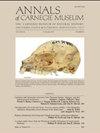The Element of Paaw in Marsupials and the Ear Region of Philander opossum (Linnaeus, 1758) (Didelphimorphia, Didelphidae)
IF 0.9
4区 地球科学
Q4 PALEONTOLOGY
引用次数: 5
Abstract
ABSTRACT A small piece of cartilage or bone, the element of Paaw, occurs in the tendon of the stapedius muscle in some extant marsupial and placental mammals. It has been nearly a century since the last comprehensive treatment of the distribution of the element of Paaw in mammals. The current report updates knowledge on this structure by synthesizing the subsequent literature and providing new observations of extant marsupials from the collections of the Section of Mammals, Carnegie Museum of Natural History, and two online resources for CT scanned data: DigiMorph.org and MorphoSource.org. We found an element of Paaw in some representatives of all seven extant marsupial orders: Didelphimorphia, Microbiotheria, Notoryctemorphia, Peramelemorphia, Paucituberculata, Dasyuromorphia, and Diprotodontia. In the first four orders, the element is substantial, longer than the long axis of the fenestra vestiuli (oval window), which holds the stapedial footplate; it is smaller than the long axis of the fenestra vestibuli in Paucituberculata and we do not have measures to report for the last two orders. In most marsupials examined, the element of Paaw contacts the petrosal behind the oval window, suggesting it functions as a sesamoid bone, increasing the lever arm of the stapedius muscle. Although there is some variability in the presence of the bone both between and within individual museum specimens, we interpret this as the result of preparation techniques rather than true variation. To place the element of Paaw in its anatomical context, we describe in detail the ear region and middle-ear auditory apparatus of the gray four-eyed opossum, Philander opossum (Linnaeus, 1758), a didelphid from Central and South America, based on a CT scanned specimen from Carnegie Museum of Natural History. It has an ossified element of Paaw with a volume greater than the stapes. Comparisons are made with petrosals of Didelphis marsupialis Linnaeus, 1758, and Monodelphis domestica (Wagner, 1842), also based on CT scanned specimens.有袋动物的脚爪成分和菲利德负鼠耳区(林奈,1758)(双吻鼠亚目,双吻鼠科)
在一些现存的有袋类和胎盘类哺乳动物的镫骨肌腱中,有一小块软骨或骨,是爪的组成部分。自从上一次对哺乳动物中爪元素的分布进行综合研究以来,已经过去了将近一个世纪。目前的报告通过综合随后的文献,并提供对现存有袋动物的新观察,这些观察来自哺乳动物部,卡内基自然历史博物馆,以及两个在线CT扫描数据资源:DigiMorph.org和MorphoSource.org。我们在所有现存的7种有袋目动物的一些代表中发现了Paaw元素:Didelphimorphia, Microbiotheria, Notoryctemorphia, Peramelemorphia, Paucituberculata, Dasyuromorphia和Diprotodontia。在前四级,元素是实质性的,比前庭窗(椭圆形窗户)的长轴还要长,后者支撑着镫骨踏板;它比包囊动物前庭窗的长轴小,我们没有最后两个目的措施报告。在大多数被检查的有袋类动物中,爪的成分接触到卵状窗后面的岩骨,表明它的功能是籽骨,增加了镫骨的杠杆臂。尽管单个博物馆标本之间和内部的骨骼存在一些差异,但我们将其解释为制备技术的结果,而不是真正的差异。为了将Paaw元素置于其解剖学背景中,我们详细描述了灰色四眼负鼠,Philander负鼠(Linnaeus, 1758)的耳朵区域和中耳听觉器官,这是一种来自中南美洲的双翅目动物,基于卡内基自然历史博物馆的CT扫描标本。它有一个骨化的爪元素,体积大于镫骨。同样基于CT扫描标本,与林奈Didelphis marsupialis Linnaeus(1758)和家蝇Monodelphis domestica (Wagner, 1842)的化石进行了比较。
本文章由计算机程序翻译,如有差异,请以英文原文为准。
求助全文
约1分钟内获得全文
求助全文
来源期刊

Annals of Carnegie Museum
综合性期刊-动物学
CiteScore
2.50
自引率
18.20%
发文量
4
审稿时长
>12 weeks
期刊介绍:
Annals of Carnegie Museum is a quarterly journal that publishes peer-reviewed short and medium-length original scientific contributions in organismal biology, earth sciences, and anthropology, in 40 by 52.5 pica format (168 by 220 mm or 6-5/8 by 8-5/8 inches). Subject matter must be relevant to Carnegie Museum of Natural History scientific sections or Powdermill Nature Reserve (PNR), preferably with connection to the Carnegie collection and/or personnel. Carnegie Museum staff and research associates receive publication priority, but others are encouraged to submit papers, especially those manuscripts explicitly based on the Carnegie collection.
 求助内容:
求助内容: 应助结果提醒方式:
应助结果提醒方式:


